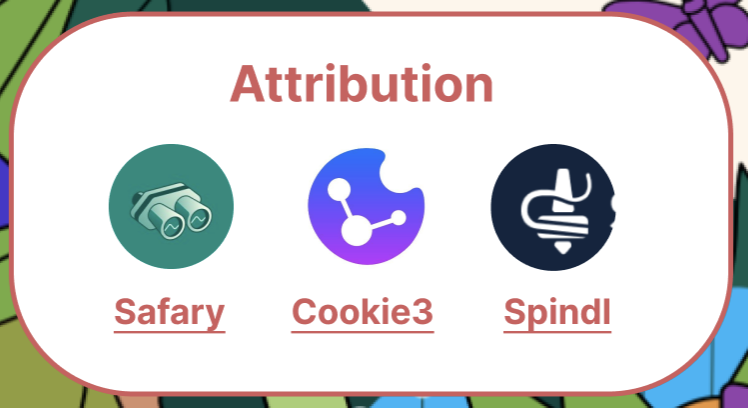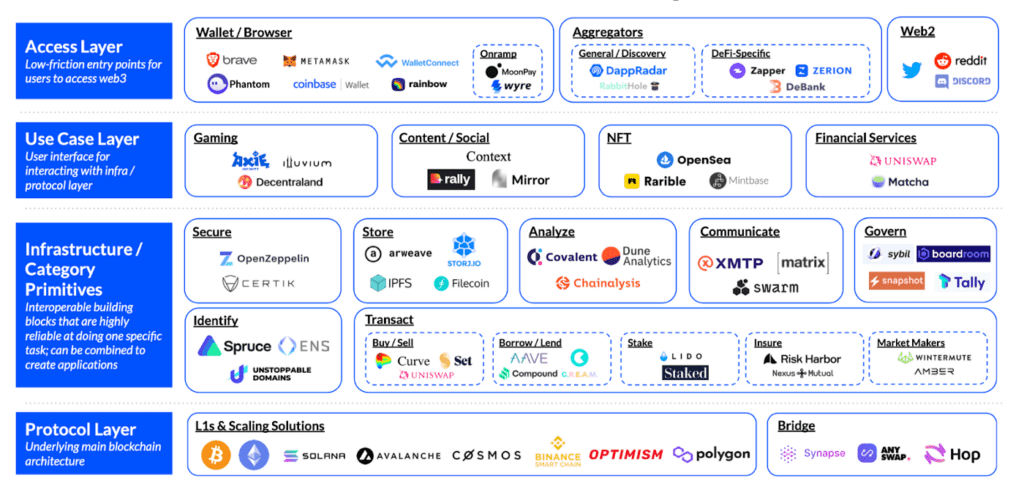Innovations in the Web3 Growth Stack category are increasingly important—tools for product managers and marketers to use Web3 technologies to acquire, attract and retain customers.

In Web2, the growth stack consists of a number of tools, platforms, and analytics systems designed to help product and marketing leaders drive growth. These tools support a structured process around user acquisition, measuring retention and engagement, and monitoring conversion and monetization—the foundation of a consumer internet business. Many of these tools have become integral to modern software development and are therefore, extremely long-lasting businesses. However, these tools—mostly built over the past decade—are unwilling or unsuitable to serve Web3 products and applications for a number of reasons.
For example, some of the largest ad networks in the world (AdSense, AdRoll) have no interest in the crypto ecosystem and even ban crypto advertisers entirely. Additionally, some of the best engagement and retention tools (Segment, Iterable, and Mixpanel) ignore the rich data that exists on-chain (similar to in-app engagement for Web2 products). To make matters worse, no one is seizing the obvious opportunity to combine in-app activity with programmatic payments, which is one of the biggest opportunities. So this means that the builders of Web3 are mostly blind and doing little to nothing in the battle for user attention on the internet.
However, this is all starting to change with the Web3 Growth Stack coming in 2023.
This post will explore crypto-native growth infrastructure. The article provides a broad overview for founders looking to build crypto-native growth tools and reasoning for growth teams at Web3 companies on how to build internal processes.

Accelerate growth using Web3 primitives
The primary catalyst for creating this window of opportunity is the deep integration of two core cryptographic primitives into growth tools for the first time.
On-chain attributes and identities
Third-party data, cookies, and fingerprinting are the fundamental building blocks of group segmentation in Web2 advertising, and they perform two core functions: attribution and identity. Attribution is the analysis of events around how and when users interact with links, pages, and applications (touchpoint trackers, referral headers, cached data). Identity is the sum of user activity used to build a target profile (session cookies, location tags, on-chain data, etc.).
Web2 attribution and identity infrastructure can be used to build rich profiles that can be aggregated across queues, targeted and served through advertising and other campaigns. These technologies can also be used in Web3 products, but Web3 products also have their own tools to identify users and their behavior. Specifically, public keys, Web3 namespaces (such as .eth and .sol), on-chain credentials, NFTs, and other on-chain activity represent a new dataset that can be used to build user profiles and segment groups.
On-chain asset ownership and emergent behavioral data provide more signals than passive browsing data because on-chain data is financial in nature. Minting NFTs, participating in governance votes, or staking protocol tokens are all acts of demonstrating meaningful interest in a given topic. For decades, advertisers have dreamed of differentiating window shoppers from real shoppers. On-chain data makes this possible.
Identity and attribution are key factors for growth, and linking crypto-native state (wallet addresses and behavior) with the Web2 state (application and browser interactions) will unlock a clearer understanding of user psychology. Web3 attributes and identity layers are just beginning to emerge. For example, we recently invested in Spindl, which is building one of the first Web3-native attribution platforms, actively building solutions that bring together Web2 and Web3 identity and engagement.

Local two-way value stream
The second primitive is the native bidirectional value flow. In Unlocking Payments with Crypto Rails, Kyle explains how Crypto Rails makes it easy for businesses to send arbitrary units of value to consumers visiting their applications/websites; the ability to move any amount of any asset between any group of individuals is Step function improvement to drive activity and distribute rewards and incentives to users.
As mentioned above, one of the biggest opportunities in the Web3 Growth Stack is tightly coupling the relationship between in-app events and programmatic on-chain payments. Web2 products cannot send value to users in real-time – but Web3 products can. This is a powerful primitive and one of the main reasons why big companies like Nike, Starbucks, and Tiffany are incorporating Web3 principles into their loyalty programs. We’ve also invested in teams like Passes, Blackbird, and Mercury to make payments and value flows to first-class citizens in the user experience.
Once these primitives are built into the core of new tools and products, the design space for growth tools expands radically.
Exploring the Web3 Growth Stack design space
Most product and marketing organizations think of growth as a funnel. In practice, they organize events, product launches, and user-specific experiences to minimize leaks in the funnel. The ultimate goal is to target specific user groups, build their behavior to increase usage, and thus create a repeatable growth strategy.
Let’s explore how the idea of Web3 affects every part of the growth funnel, starting at the top of user acquisition, all the way to engagement and ultimately retention.
User acquisition
User acquisition describes how the product discovers, acquires, and activates new users. Demand generation – primarily through advertising – is usually the first step. Roughly speaking, in order to serve an ad, one must have:
- Advertising material (creative)
- Ad Queue (Targeting)
- Delivery carrier (display)
- Advertising platform (sales)
- In order to place ads on publishers’ sites in real time, there is a two-way market between publishers and advertisers, with an exchange in the middle to mediate transactions (advertisers’ placements as bids, publishers’ inventory as inquiries).
Advertisers target users who meet a set of characteristics or criteria associated with a higher probability of conversion, and users are likely to have a better experience with the publisher when the ads they see are relevant to them. More comprehensive targeted user profiles can be developed using on-chain data bundled with off-chain first-party or third-party data, enabling higher quality segmentation and cohort building. For example, for advertisers, knowing if the people they are targeting with their precious advertising dollars is active on StepN, holds more than 150 SOL in their wallet, or participates in any virtual world where in-store merchandise can be showcased.
There are already crypto-native ad exchanges (Slise), networks (Hypelab) and demand-side platforms (Myosin). As inferences around user behavior become higher fidelity with on-chain data, we expect more follow-up, which will lead to better segmentation, queue building, and higher quality for end users experience. Advertising infrastructure has inherent network effects gained by intermediating the communication between advertisers and publishers, and has the potential to capture significant value.
However, this is just the tip of the iceberg. As on-chain identity and attribution data is combined with in-app event data, we expect to see improvements in the ad units themselves. For example, when a user is presented with a banner ad, she can view it (impression) or click it and visit the website (click). Web3-enabled ad units may enable targeted users to earn instant rewards or make purchases directly on the ad itself without leaving the page they are on. This can have downstream effects on core advertising metrics such as cost-per-click and cost-per-impression and cost-per-transaction. For example, imagine:
“Showing ads for NFT collectibles, allowing users to mint directly from the publisher’s page—rather than being redirected to another page—and rewarding users (or publishers who enable these transactions) with tokens. This alone reduces A user journey of at least one click. The concept is similar to Facebook’s innovative lead generation ads, which shorten the funnel and keep users in the publisher’s experience instead of sending them away.”
Once websites become Web3 wallet-aware (Shopify is already working on “token-gated commerce”), they should be able to react and rebuild dynamically based on user preferences and their value to advertisers. As part of a “Web3-responsive” innovative website, affiliate links will have the potential to change dynamically based on consumer roles and values. It’s easy to imagine advertisers willing to pay more for repeat visitors if they can demonstrate that the model improves repeat visits, retention, or LTV.
Search for ads that automatically airdrop tokens or send messages to users, whether or not the viewer interacts with the ad itself. This allows advertisers to target users directly based on intent.
In addition to innovations in advertising, we believe that the design space for direct outbound marketing is maturing and developing in cryptocurrency. It’s worth noting that design spaces, as a constant line of communication with end users, are a powerful user acquisition tool. Encrypted messaging protocols are in their early stages, with protocols like Dialect, XMTP, and Nansen Connect establishing the standard for messaging and notifications. These tools are a key element of Web3 native, just like Twilio, Iterable, and Intercom have been for the past decade.
Today’s advertising model is that advertisers flood users with information, hoping to attract attention at the right time. In the future, advertisers could price the cost of a message and pass on a built-in economic incentive for users to read it. We can imagine a future of dynamic inboxes where value can be added to messages and mail/messaging apps can automatically push value-laden messages to the top of the inbox. Inbox itself could profit from these rules and give users the flexibility to choose effective filters or configurations, while allowing advertisers to target high-value users.

Maintaining communication is critical to the activation and retention of new users.
Participation
Once users start using a product, it becomes critical to understand how they interact with it. Who decides to participate and what drives them? Where in the product is the most time spent, and where should more time be spent? Who returns the product once and who returns 20 times in a month? At what point in the process do most users leave?
The answers to these questions provide insight into the future direction of the product and how to keep customers happy in the first place.
Web2 tools like Segment and Fullstory provide product teams with detailed data about who is doing what in their applications. Every check-in, button click, scroll, click, and purchase is a recorded event, time-stamped along the journey, giving product teams insight into how users interact with the product.
The Mode, Looker, and Heap dashboards paint a picture of overall retention by showing how groups are performing on user acquisition campaigns and product improvements. Fine-tuning a product based on engagement data from highly active users versus high-churners can help inform critical decisions.
Crypto-native teams like Raleon, Merlin, and Garden are all experimenting within the design space where Web2 engagement tools intersect with on-chain attribution and identity. If product and growth teams can establish causal relationships between granular actions in their applications and users’ on-chain roles, they will be able to make more informed decisions about inflection points in the product lifecycle.
In addition to bundling on-chain transactions and behaviors, a key difference between Web3 products and their predecessors is that they are often places where digital goods with clear financial value are exchanged. If there are financial incentives to fight for, there will be a race to get them first, and the bot will win. This problem has been bothering the Web3 team because there is no proper tool to solve this problem. Web2 brands entering Web3 will also quickly learn that they, too, need growth analytics to help identify and contain Sybil attacks.
Sybil attacks can have a strong adverse effect on product sustainability. Fine-grained event analysis and evolving proof-of-humanity credentials should address these issues and help product teams understand which of their users are real and which are bots.
User-facing products built over the next few years will leverage a set of related on-chain protocols, but most users don’t interact with the protocols themselves — they’re dealing with applications built on top of the protocols. The protocol team is very interested in how end users use the core low-level primitives. Product-level engagement data is much richer and includes far more attributes than the on-chain data accessible to protocol teams. We believe that this kind of product engagement data might even be seen as a form of payment from product teams to protocol teams in the future.
Retain
The more mature growth team is very concerned about the loyalty and reservation rate of customers; retaining a customer is usually lower than the cost of getting a new customer. Web3 identity and attribute data provides new methods for product teams to do this. It can be said that it has a more powerful incentive model than web2 products.
The core commitment of the encrypted original saying is to achieve the coordination of large -scale activities through incentives. There is a huge opportunity to use these primitives to enhance the web3 retention layer. For example, free games can provide NFT or alternative to tokens, allowing users to return to the game every day. Snapchat’s encrypted native versions can release continuous collectibles or verified snapshots to provide continuous participation to provide quantifiable social status. A core unlock of the encrypted retention layer is that if the product can be rewarded in the form of state and utility, they can now allocate rewards in the form of state, utility and financial value.
Several projects are building infrastructure independently. Galxe is constructing a certificate on the chain and other attending proof of NFT; projects such as APTOS and OPTIMISM are providing targeted airdrops for early users and builders; , Community telephone, gathering, etc.) to maintain the participation and reservation of community members. These growth teams show users to the status or practical object of product delivery, which penetrate into the user community and specifically their value. Teams and other teams such as Rabbithole, Layer3 and Sonder are also leading in this regard.
Incentives are necessary, but not enough for users to stay for a long time. The ideal of web3 is sovereignty, ownership, and no license, especially the type of centralized platform type that opposes the dependence of the previous generation of consumer products. Therefore, the web3 data transplantability and combinedability are excellent. This has caused because web3 products may allow users to have a platform they are building, but they still need to cultivate customers’ affinity like consumer products in the past ten years.
Cultivating customer affinity by reuse the use of cryptocurrencies will largely depend on customer experience and actively retain activities. Historically, the web3 platform stood out by discovering, management, trust, and reputation. Leaders in the encrypted fields such as Binance, Magic Eden, and Phantom provide users with a higher degree of convenience than their competitors, which in turn enables them to get user attention on a large scale. Web3 products that treat end users as priority matters, whether the complexity of encrypted primitives is abstracted or with a special user support team, may benefit from the attention of users on the next wave of chains.
New incentive model
At the beginning of this post, we argued that the two most important models for Web3 growth are crypto-native attribution and identity, and native two-way value transfer. Going forward, intrusive data tracking tools (e.g. cookies, event trackers, fingerprints, third-party data marketplaces) may be phased out as strong regulatory rules such as GDPR, CCPA come into effect. At that time, new privacy protection platforms, data sovereignty tools, and next-generation digital growth platforms will replace the old platforms.
In addition to all the above ideas, we are excited about targeted solutions in the following areas:
- DataDAO – For users who choose to share their data in a privacy-preserving manner, DataDAO is building an incentive system to give them value as advertisers and publishers.
- Privacy-First Ad Exchange – Brave’s Themis uses zero-knowledge proofs to build a decentralized ad exchange. Around on-chain attribution and trust minimization, they treat user privacy as a first-class object. Can other companies develop high-quality privacy-preserving ad exchange experiences?
- New crypto-native ad units – whether at the UI layer (such as creating NFTs by clicking on ads), or at the ad platform or database layer (such as hosting ad exchanges on Solana, hosting ad content on Ceramic or Tableland), will A new type of encrypted primitive ad unit appears.
- Sybil Resistance and Proof of Humanity – How can a user prove that an on-chain address belongs to a human (and not a bot), while analyzing that a single user owns multiple addresses? We believe that cryptocurrencies are in a great age of application and product experimentation, and growth tools are critical to their success.
DISCLAIMER: The Information on this website is provided as general market commentary and does not constitute investment advice. We encourage you to do your own research before investing.
Join us to keep track of news: https://linktr.ee/coincu
Harold
Coincu News














